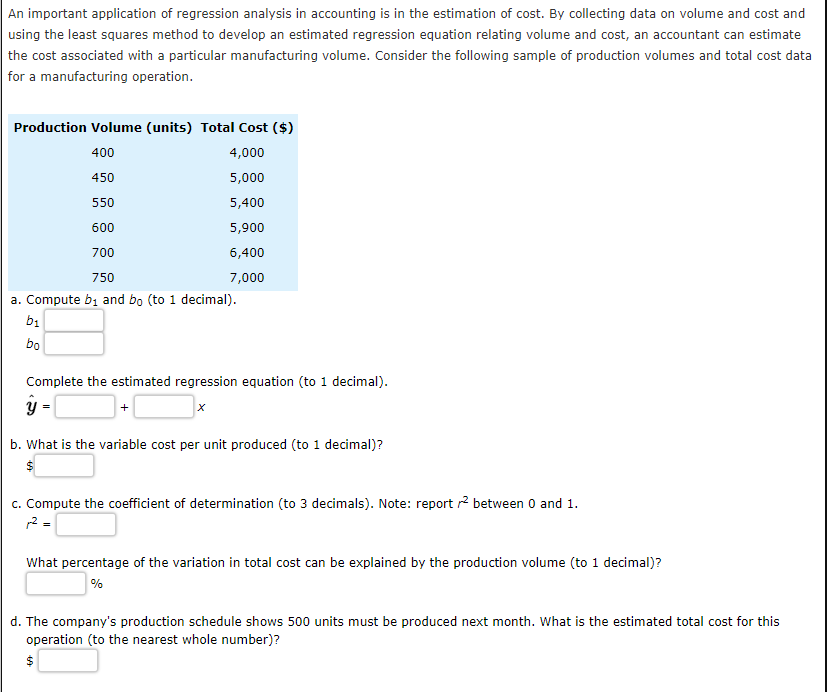Production Volume (units) Total Cost ($) 400 4,000 450 5,000 550 5,400 600 5,900 700 6,400 750 7,000 a. Compute b, and bo (to 1 decimal). bo Complete the estimated regression equation (to 1 decimal). b. What is the variable cost per unit produced (to 1 decimal)? c. Compute the coefficient of determination (to 3 decimals). Note: report ? between 0 and 1. What percentage of the variation in total cost can be explained by the production volume (to 1 decimal)? % d. The company's production schedule shows 500 units must be produced next month. What is the estimated total cost for this operation (to the nearest whole number)?
Production Volume (units) Total Cost ($) 400 4,000 450 5,000 550 5,400 600 5,900 700 6,400 750 7,000 a. Compute b, and bo (to 1 decimal). bo Complete the estimated regression equation (to 1 decimal). b. What is the variable cost per unit produced (to 1 decimal)? c. Compute the coefficient of determination (to 3 decimals). Note: report ? between 0 and 1. What percentage of the variation in total cost can be explained by the production volume (to 1 decimal)? % d. The company's production schedule shows 500 units must be produced next month. What is the estimated total cost for this operation (to the nearest whole number)?
Linear Algebra: A Modern Introduction
4th Edition
ISBN:9781285463247
Author:David Poole
Publisher:David Poole
Chapter7: Distance And Approximation
Section7.3: Least Squares Approximation
Problem 31EQ
Related questions
Question

Transcribed Image Text:An important application of regression analysis in accounting is in the estimation of cost. By collecting data on volume and cost and
using the least squares method to develop an estimated regression equation relating volume and cost, an accountant can estimate
the cost associated with a particular manufacturing volume. Consider the following sample of production volumes and total cost data
for a manufacturing operation.
Production Volume (units) Total Cost ($)
400
4,000
450
5,000
550
5,400
600
5,900
700
6,400
750
7,000
a. Compute b, and bo (to 1 decimal).
b1
bo
Complete the estimated regression equation (to 1 decimal).
b. What is the variable cost per unit produced (to 1 decimal)?
c. Compute the coefficient of determination (to 3 decimals). Note: report r? between 0 and 1.
2 =
What percentage of the variation in total cost can be explained by the production volume (to 1 decimal)?
%
d. The company's production schedule shows 500 units must be produced next month. What is the estimated total cost for this
operation (to the nearest whole number)?
24
Expert Solution
This question has been solved!
Explore an expertly crafted, step-by-step solution for a thorough understanding of key concepts.
Step by step
Solved in 2 steps

Recommended textbooks for you

Linear Algebra: A Modern Introduction
Algebra
ISBN:
9781285463247
Author:
David Poole
Publisher:
Cengage Learning


Algebra & Trigonometry with Analytic Geometry
Algebra
ISBN:
9781133382119
Author:
Swokowski
Publisher:
Cengage

Linear Algebra: A Modern Introduction
Algebra
ISBN:
9781285463247
Author:
David Poole
Publisher:
Cengage Learning


Algebra & Trigonometry with Analytic Geometry
Algebra
ISBN:
9781133382119
Author:
Swokowski
Publisher:
Cengage

Glencoe Algebra 1, Student Edition, 9780079039897…
Algebra
ISBN:
9780079039897
Author:
Carter
Publisher:
McGraw Hill

Big Ideas Math A Bridge To Success Algebra 1: Stu…
Algebra
ISBN:
9781680331141
Author:
HOUGHTON MIFFLIN HARCOURT
Publisher:
Houghton Mifflin Harcourt